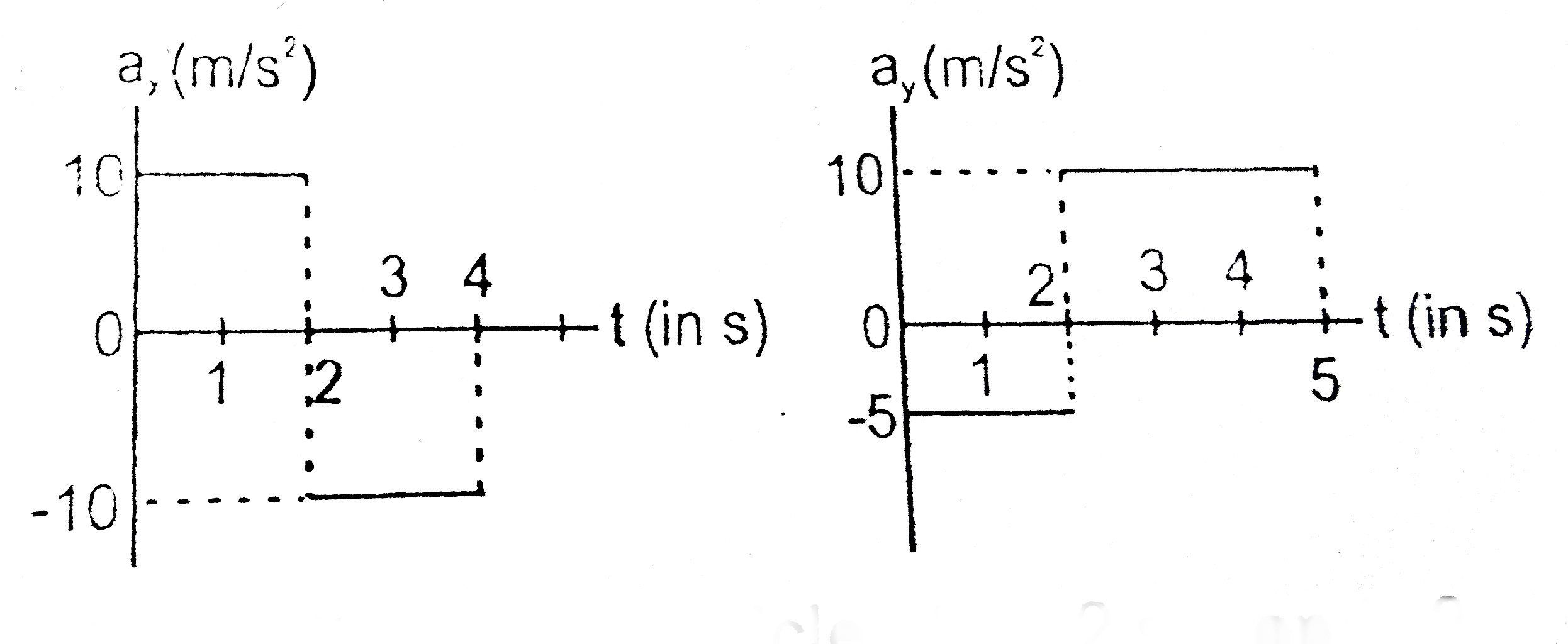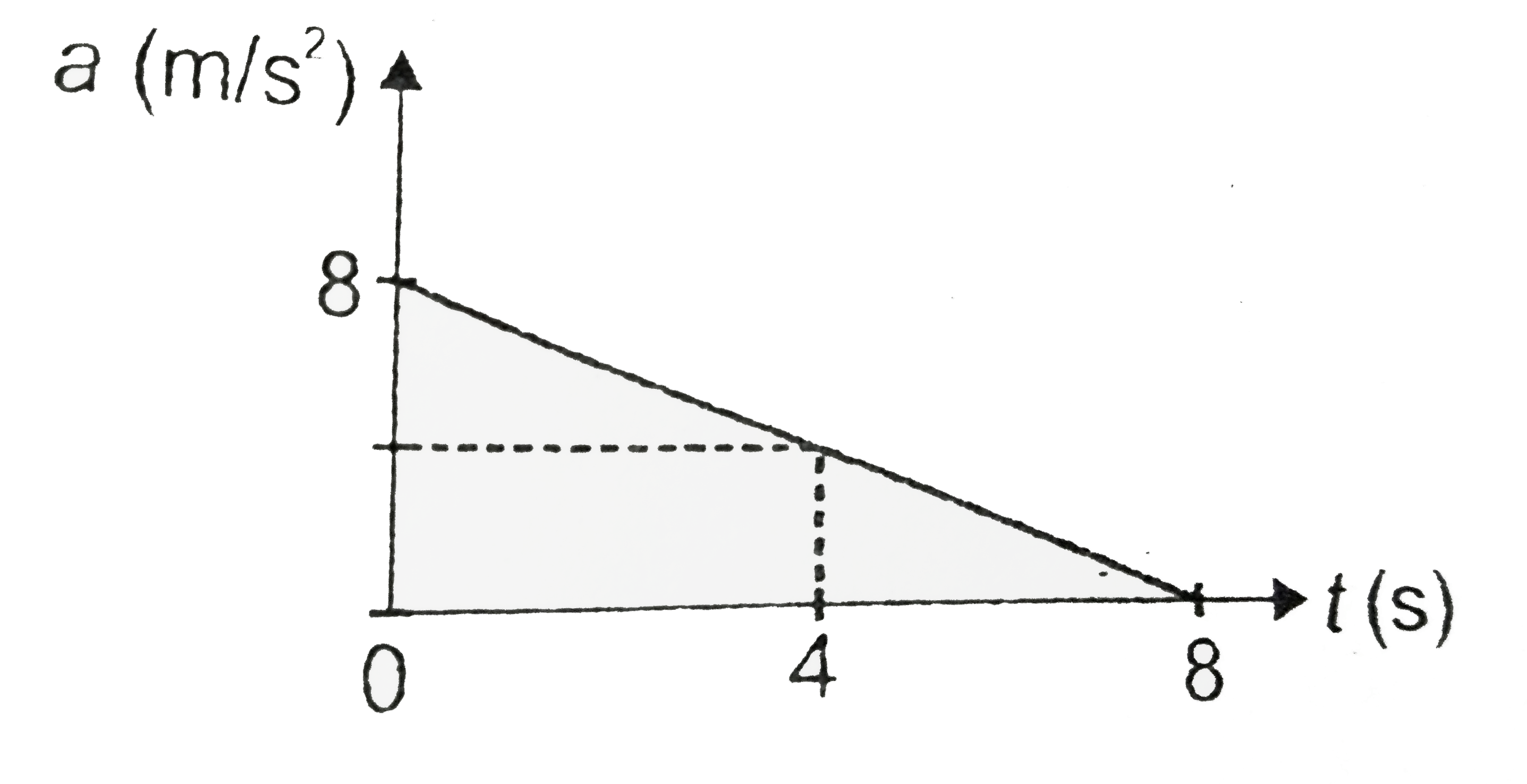A particle which is initially at rest at the origin, is subjection to an acceleration with x- and y- components as shown. After time t=5 , the particle has no acceleration.
What is the magnitude of average velocity of the particle between t=0 and t=4 seconds ?
A. 52√13m/s
B. 52√17m/s
C. 30m/s
D. None of these
52√13m/s
52√17m/s
30m/s
None of these
The correct Answer is:B
To solve the problem step by step, we need to find the average velocity of the particle between t=0 and t=4 seconds. The average velocity is defined as the total displacement divided by the total time taken.
Step 1: Understand the problem
The particle starts from rest at the origin (0, 0). We need to calculate the displacement in both the x and y directions over the time interval from t=0 to t=4 seconds.
Step 2: Determine the acceleration components
From the information provided:
- For the first 2 seconds (from t=0 to t=2):
- Acceleration in the x-direction, ax=10m/s2
- Acceleration in the y-direction, ay=−5m/s2
- For the next 2 seconds (from t=2 to t=4):
- The particle continues with the velocities obtained at t=2 seconds, but the acceleration in the x-direction is still ax=10m/s2 and in the y-direction is ay=−5m/s2.
Step 3: Calculate displacement in the x-direction
Using the equation of motion:
s=ut+12at2
For the first 2 seconds:
- Initial velocity u=0
- t=2
- ax=10
Displacement in x-direction (x1):
x1=0+12⋅10⋅(22)=0+12⋅10⋅4=20m
For the next 2 seconds (from t=2 to t=4):
- Initial velocity at t=2 is vx=ax⋅t=10⋅2=20m/s
- t=2
- ax=10
Displacement in x-direction (x2):
x2=20⋅2+12⋅10⋅(22)=40+12⋅10⋅4=40+20=60m
Total displacement in x-direction:
Δx=x1+x2=20+60=80m
Step 4: Calculate displacement in the y-direction
For the first 2 seconds:
- Initial velocity u=0
- t=2
- ay=−5
Displacement in y-direction (y1):
y1=0+12⋅(−5)⋅(22)=0−12⋅5⋅4=−10m
For the next 2 seconds (from t=2 to t=4):
- Initial velocity at t=2 is vy=−10m/s
- t=2
- ay=−5
Displacement in y-direction (y2):
y2=−10⋅2+12⋅(−5)⋅(22)=−20−12⋅5⋅4=−20−10=−30m
Total displacement in y-direction:
Δy=y1+y2=−10−30=−40m
Step 5: Calculate the total displacement
The total displacement Δs is given by:
Δs=√(Δx)2+(Δy)2=√(80)2+(−40)2=√6400+1600=√8000=20√20m
Step 6: Calculate average velocity
Average velocity Vavg is given by:
Vavg=ΔsΔt=20√204=5√20m/s
Step 7: Simplify the average velocity
We can simplify 5√20:
5√20=5√4⋅5=5⋅2√5=10√5m/s
Final Answer
The magnitude of the average velocity of the particle between t=0 and t=4 seconds is 10√5m/s.
The particle starts from rest at the origin (0, 0). We need to calculate the displacement in both the x and y directions over the time interval from t=0 to t=4 seconds.
From the information provided:
- For the first 2 seconds (from t=0 to t=2):
- Acceleration in the x-direction, ax=10m/s2
- Acceleration in the y-direction, ay=−5m/s2
- The particle continues with the velocities obtained at t=2 seconds, but the acceleration in the x-direction is still ax=10m/s2 and in the y-direction is ay=−5m/s2.
Using the equation of motion:
s=ut+12at2
For the first 2 seconds:
- Initial velocity u=0
- t=2
- ax=10
x1=0+12⋅10⋅(22)=0+12⋅10⋅4=20m
- Initial velocity at t=2 is vx=ax⋅t=10⋅2=20m/s
- t=2
- ax=10
x2=20⋅2+12⋅10⋅(22)=40+12⋅10⋅4=40+20=60m
Δx=x1+x2=20+60=80m
For the first 2 seconds:
- Initial velocity u=0
- t=2
- ay=−5
y1=0+12⋅(−5)⋅(22)=0−12⋅5⋅4=−10m
- Initial velocity at t=2 is vy=−10m/s
- t=2
- ay=−5
y2=−10⋅2+12⋅(−5)⋅(22)=−20−12⋅5⋅4=−20−10=−30m
Δy=y1+y2=−10−30=−40m
The total displacement Δs is given by:
Δs=√(Δx)2+(Δy)2=√(80)2+(−40)2=√6400+1600=√8000=20√20m
Average velocity Vavg is given by:
Vavg=ΔsΔt=20√204=5√20m/s
We can simplify 5√20:
5√20=5√4⋅5=5⋅2√5=10√5m/s
The magnitude of the average velocity of the particle between t=0 and t=4 seconds is 10√5m/s.
Topper's Solved these Questions
- DAILY PRACTICE PROBLEMSBOOK - RESONANCE ENGLISHCHAPTER - DAILY PRACTICE PROBLEMSEXERCISE - dpp 70
7 Videos
- DAILY PRACTICE PROBLEMSBOOK - RESONANCE ENGLISHCHAPTER - DAILY PRACTICE PROBLEMSEXERCISE - dpp 71
8 Videos
- DAILY PRACTICE PROBLEMSBOOK - RESONANCE ENGLISHCHAPTER - DAILY PRACTICE PROBLEMSEXERCISE - dpp 69
5 Videos
- CURRENT ELECTRICITYBOOK - RESONANCE ENGLISHCHAPTER - CURRENT ELECTRICITYEXERCISE - Exercise
53 Videos
- ELASTICITY AND VISCOCITYBOOK - RESONANCE ENGLISHCHAPTER - ELASTICITY AND VISCOCITYEXERCISE - Advanced Level Problems
9 Videos
Similar Questions
A particle which is initially at rest at the origin, is subjection to an acceleration with x− and y− components as shown. After time t=5 , the particle has no acceleration.

What is the magnitude of velocity of the particle at t=2 seconds ?
View SolutionA particle which is initially at rest at the origin, is subjection to an acceleration with x− and y− components as shown. After time t=5 , the particle has no acceleration.

When is the particle at its farthest distance from the y− axis ?
A. 3 sec.
B. 2 sec.
C. 4 sec.
D. 1 sec.
View SolutionStarting from rest, the acceleration of a particle is a=2(t-1). The velocity of the particle at t=5s is :-
View SolutionIf acceleration a(t)=3t2 and initial velocity u=0 m/s , then the velocity of the particle after time t=4 s
View SolutionA particle starts from rest and moves with an acceleration of a={2+|t−2|}m/s2 The velocity of the particle at t=4 sec is
View SolutionA particle starts from rest and moves with an acceleration of a={2+|t−2|}m/s2 The velocity of the particle at t=4 sec is
View SolutionStarting from rest, a particle rotates in a circle of radius R = √2m with an angular acceleration = π4 rad/s2.The magnitude of average velocity of the particle over the time it rotates quarter circle is:
View SolutionA particle, initially at rest, starts moving in a straight line with an acceleration a=6t+4m/s2. The distance covered by it in 3 s is
View SolutionThe acceleration-time graph of a particle moving along x-axis is shown in the figure. If the particle starts with velocity 3 m/s at t = 0, find the velocity of particle at t = 4 s.

View SolutionThe velocity of an object moving rectilinearly is given as a function of time by v=4t−3t2 where v is in m/s and t is in seconds. The average velocity if particle between t=0 to t=2 seconds is
View Solution
